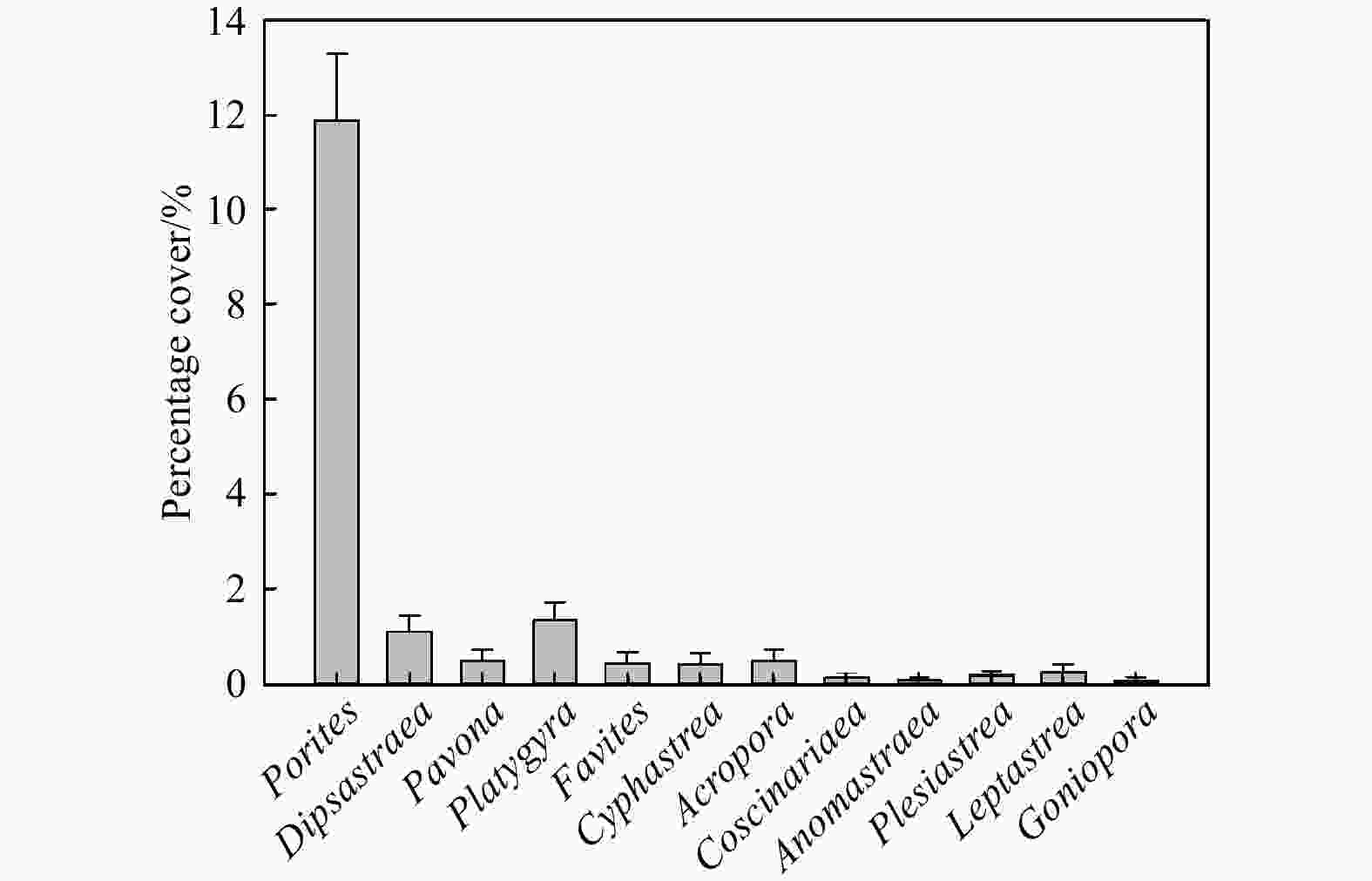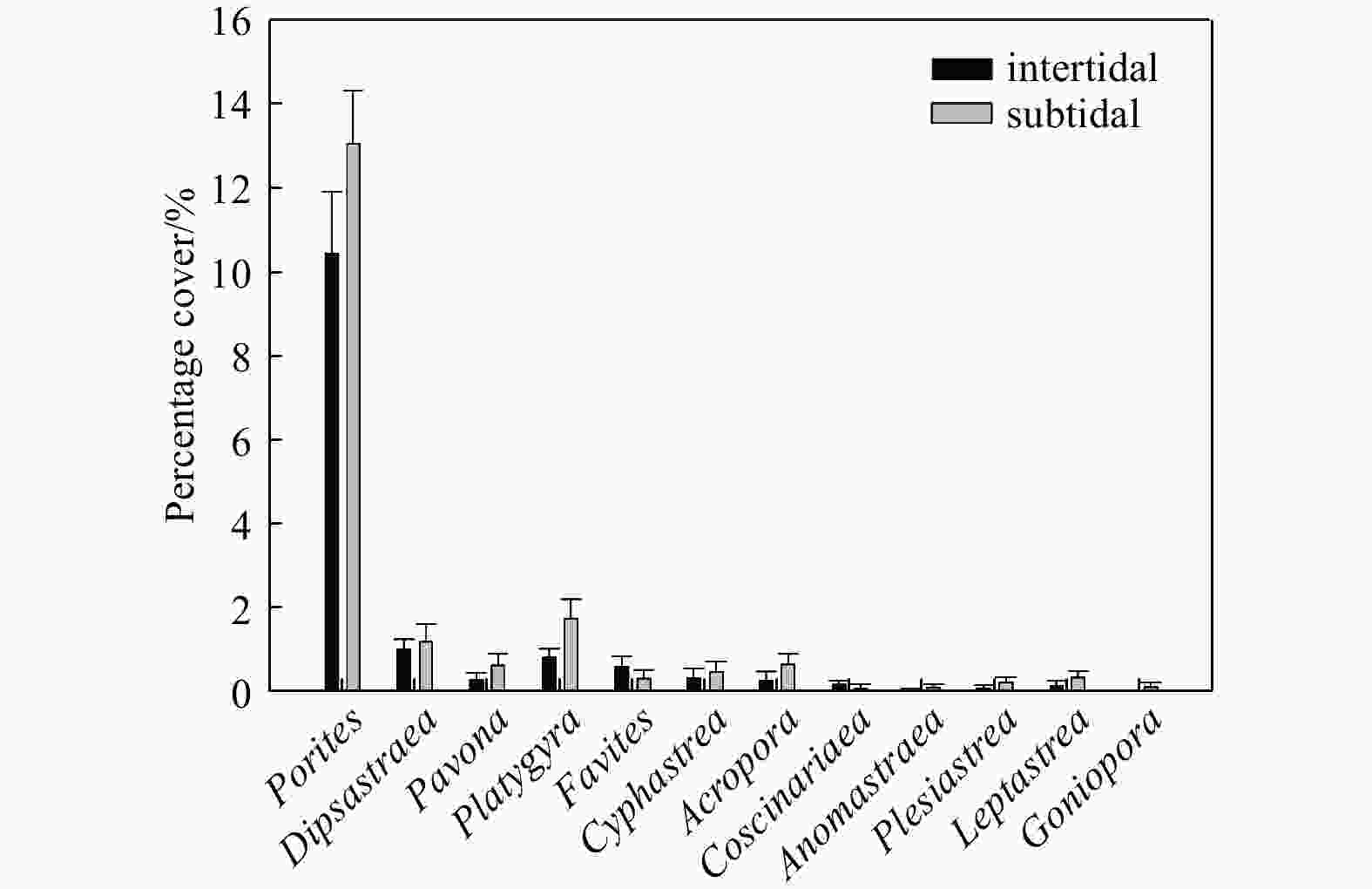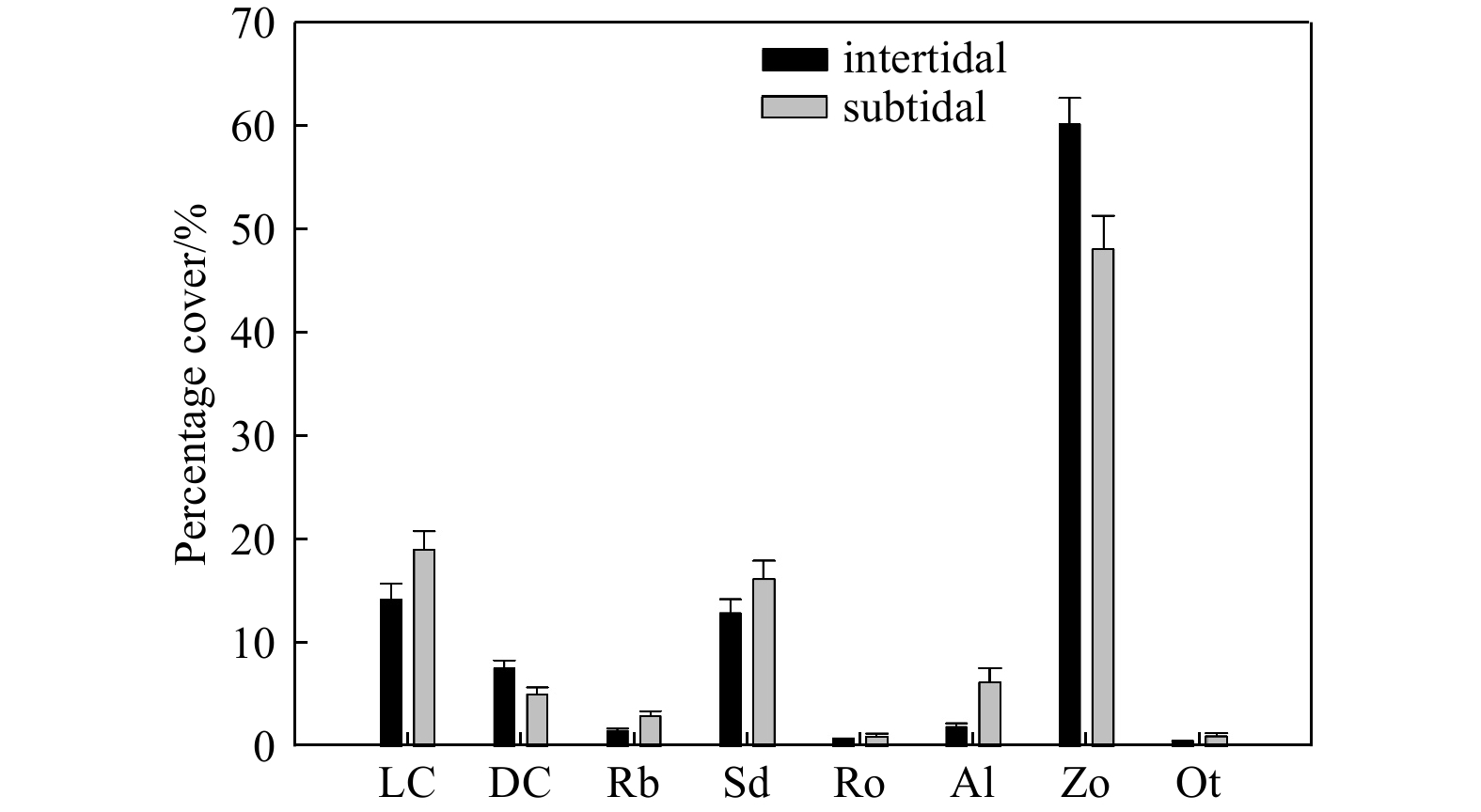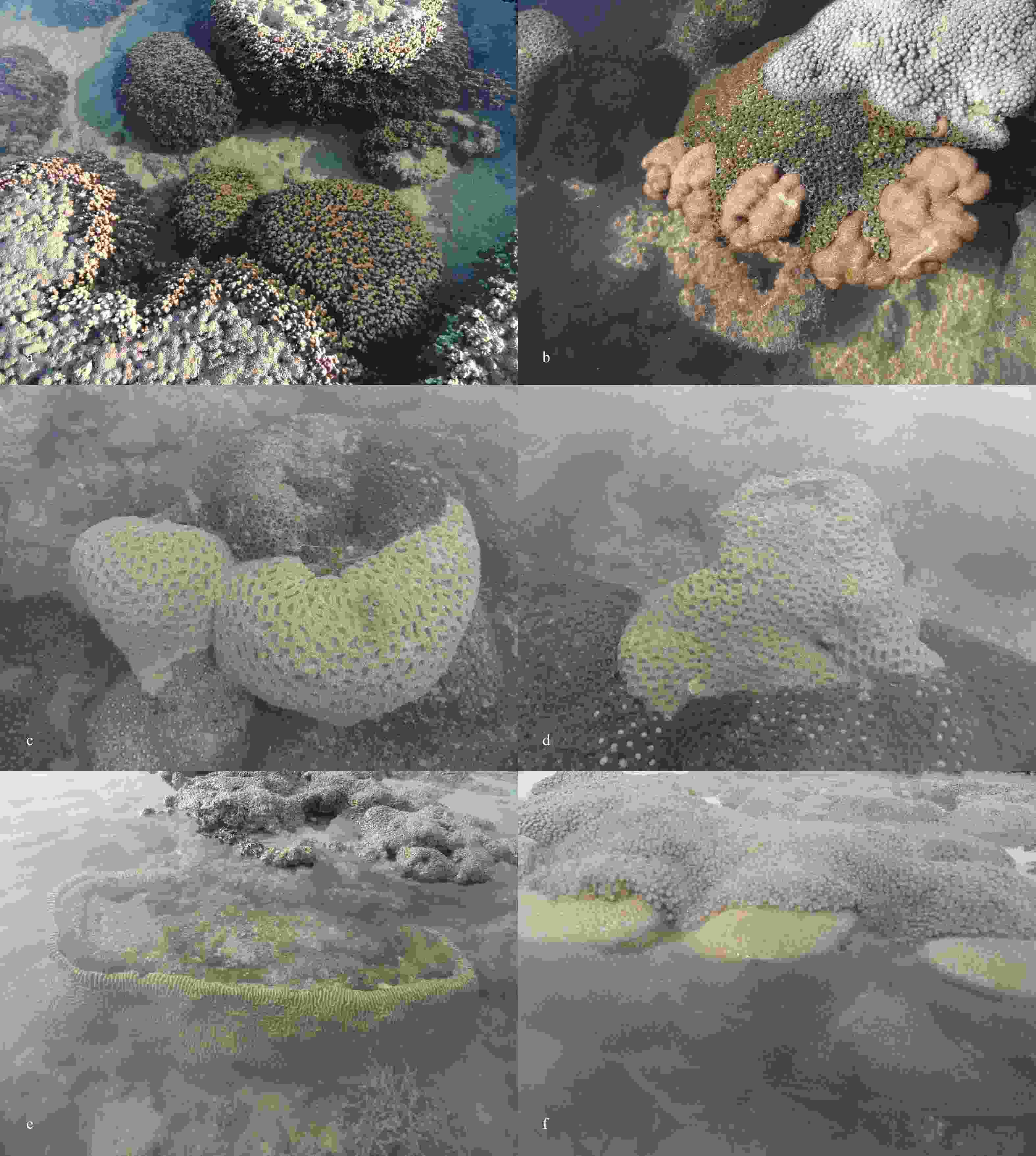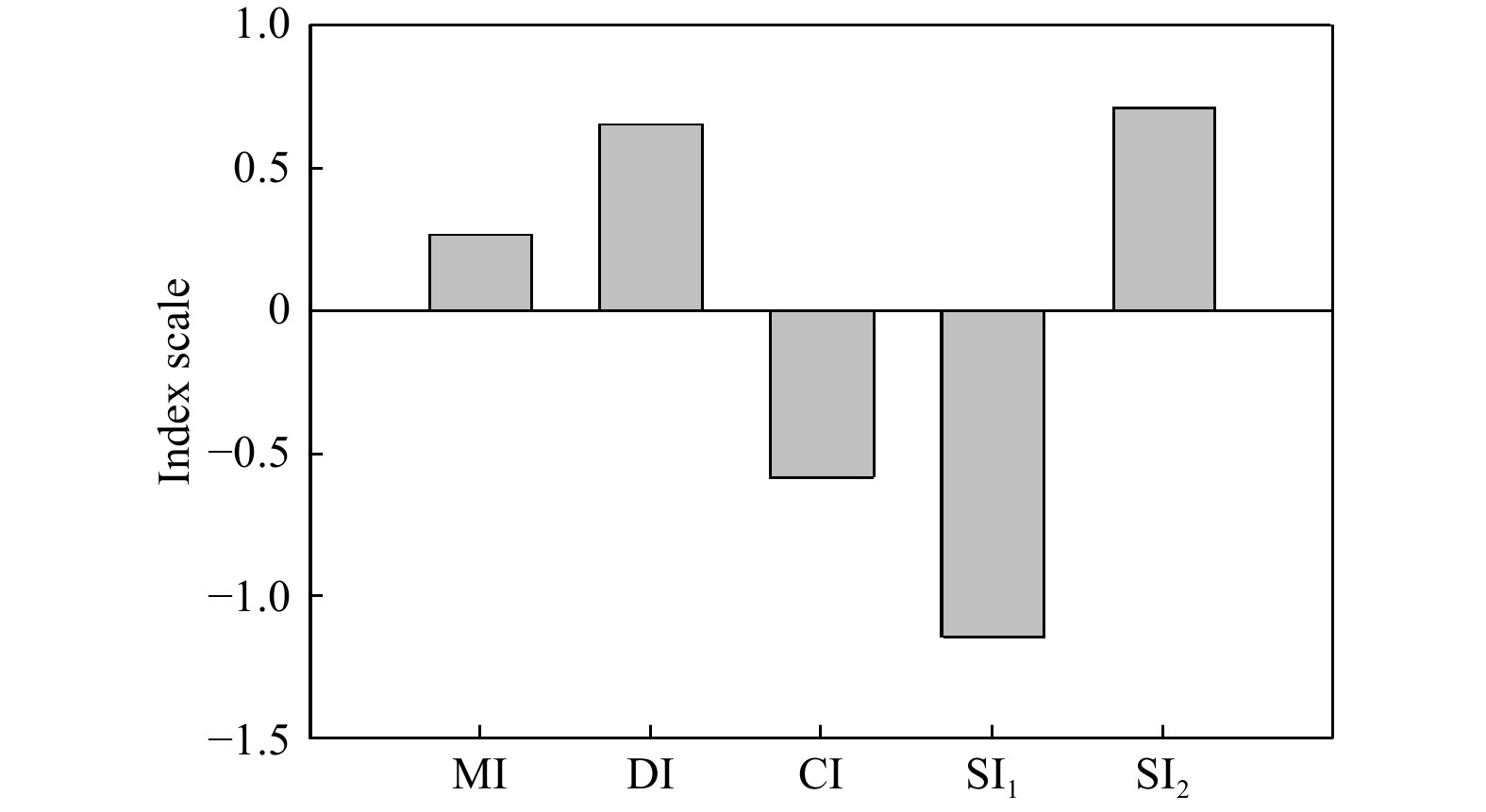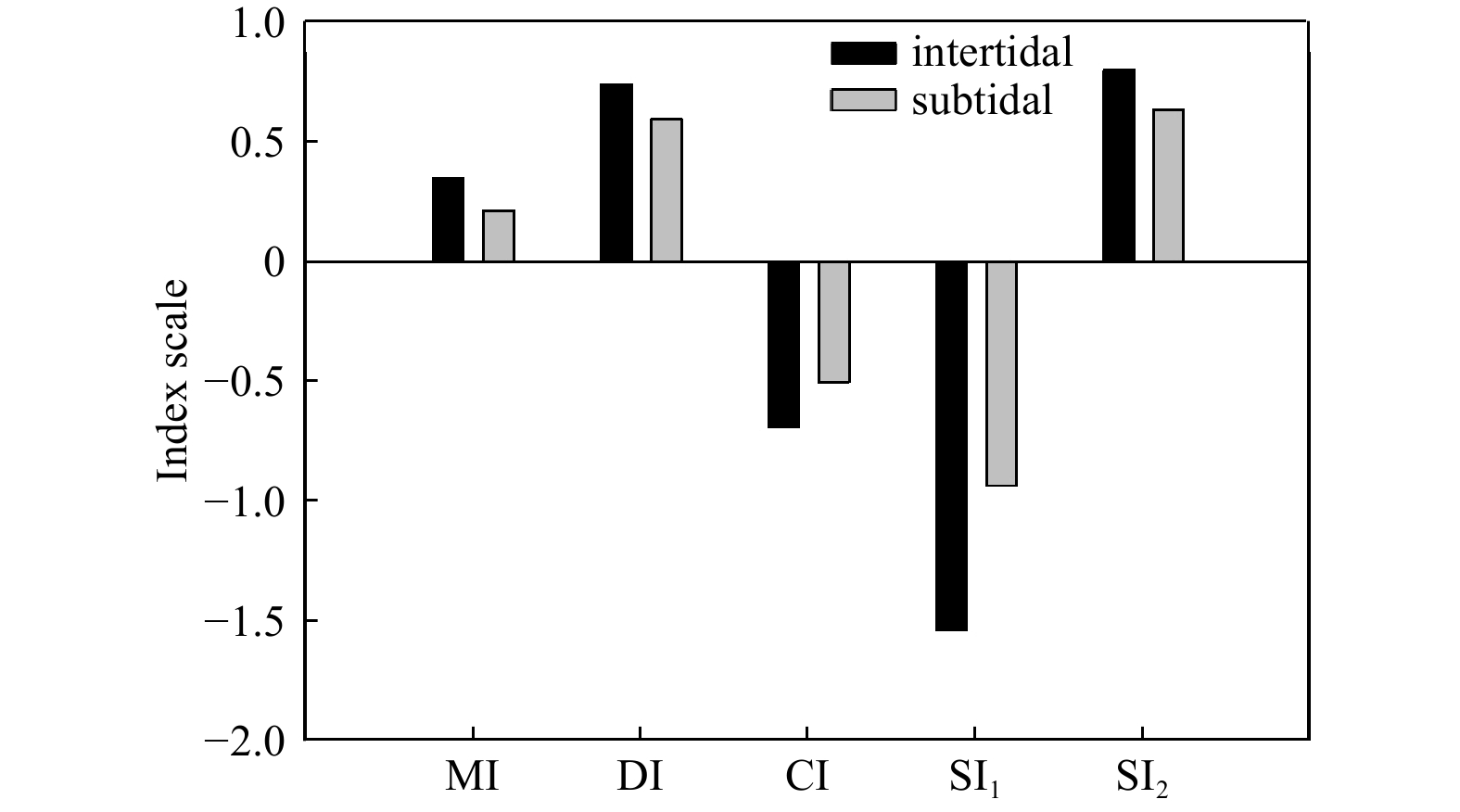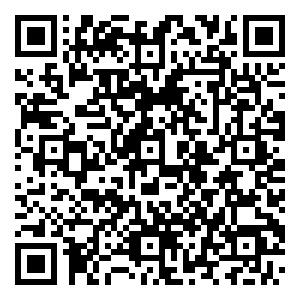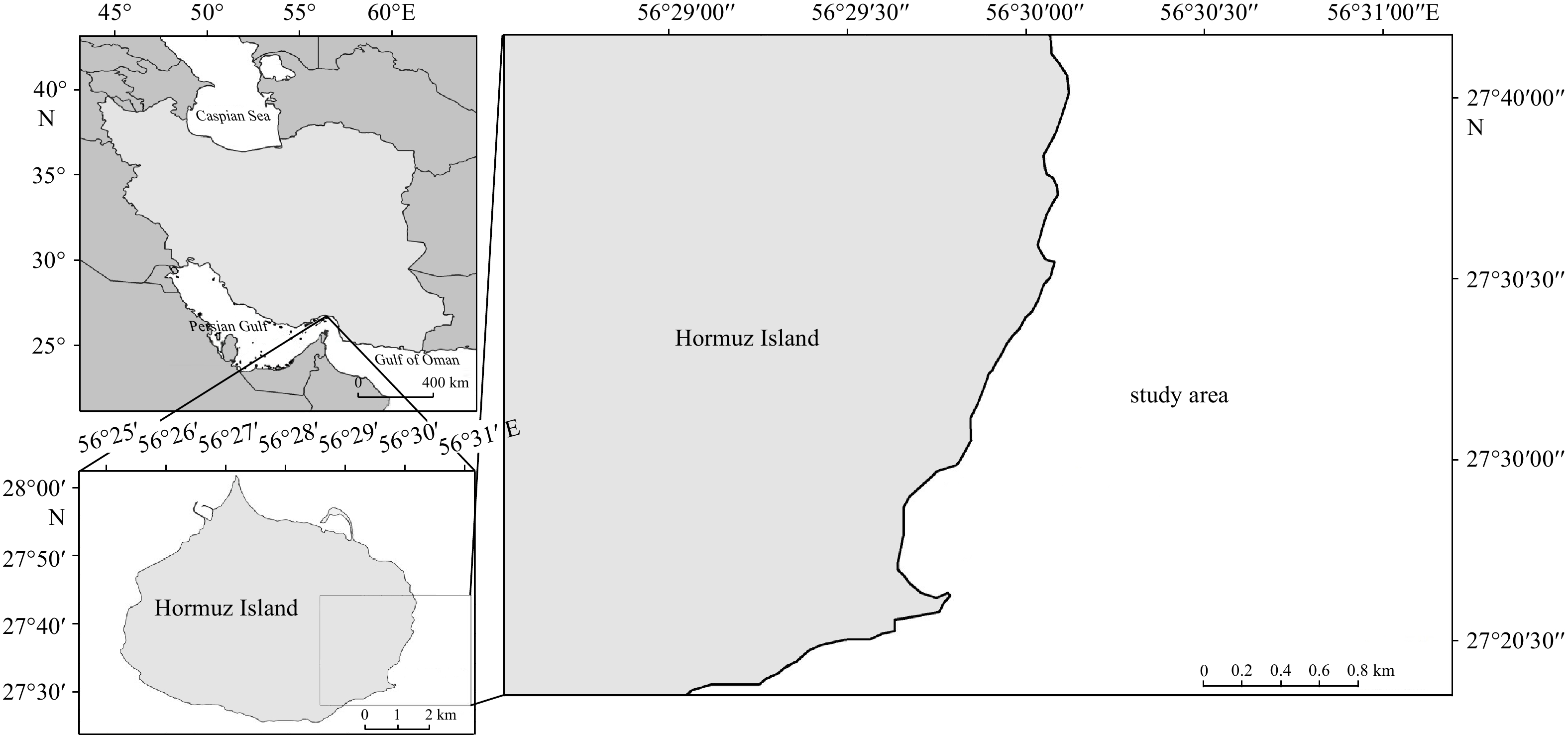-
Abstract: The abundance and health of scleractinian coral communities of Hormuz Island were investigated. For this purpose, we employed 20 m line intercept transects—12 in the intertidal zone and 15 subtidally to evaluate coral cover and community composition. The estimated dead coral coverage was 6.21%±0.81%, while live coral coverage was 16.93%±1.81%, considered as very poor. Totally, 12 genera were recorded, of which Porites with 11.9%±1.4% live cover was the dominant, while Goniopora had the least cover (0.07%±0.08%). Based on Mann-Whitney U-test, live coral coverage, dead coral coverage, algal coverage, cover of other benthic organisms and abiotic components showed significant univariate differences between zones (p<0.05). The Spearman correlation test between the abundance of biotic and abiotic components indicated significant negative correlation of live coral and sand with zoantharian and significant positive correlation of algae and other benthic organisms with rubble. The reef health indices used for the corals indicated that, in general, the environmental conditions were not suitable, which could be attributed to both natural and anthropogenic factors, the most important of which was zoantharian’ overgrowth on the scleractinian corals in this region.
-
Key words:
- scleractinian corals /
- zoantharian /
- reef health indices /
- Hormuz Island /
- Persian Gulf
-
Table 1. Location and depth of the transects at the study site
Transect Latitude Longitude Depth/m Zone Transect 1 27°03'00.14"N 56°30'03.27"E < 1 intertidal Transect 2 27°03'01.64"N 56°30'03.75"E < 1 intertidal Transect 3 27°03'04.69"N 56°30'05.43"E < 1 intertidal Transect 4 27°03'07.92"N 56°30'04.91"E < 1 intertidal Transect 5 27°03'12.81"N 56°30'04.57"E < 1 intertidal Transect 6 27°03'18.41"N 56°30'04.09"E < 1 intertidal Transect 7 27°03'21.22"N 56°30'06.29"E < 1 intertidal Transect 8 27°03'20.92"N 56°30'09.13"E < 1 intertidal Transect 9 27°03'25.83"N 56°30'08.20"E < 1 intertidal Transect 10 27°03'29.18"N 56°30'08.66"E < 1 intertidal Transect 11 27°03'32.80"N 56°30'08.88"E < 1 intertidal Transect 12 27°03'37.95"N 56°30'10.02"E < 1 intertidal Transect 13 27°02'48.10"N 56°30'10.31"E < 5 subtidal Transect 14 27°02'46.61"N 56°30'17.90"E < 5 subtidal Transect 15 27°03'01.06"N 56°30'20.29"E < 5 subtidal Transect 16 27°03'08.30"N 56°30'14.95"E < 5 subtidal Transect 17 27°03'05.95"N 56°30'24.82"E < 5 subtidal Transect 18 27°03'10.06"N 56°30'15.87"E < 5 subtidal Transect 19 27°03'08.12"N 56°30'24.95"E < 5 subtidal Transect 20 27°03'11.25"N 56°30'15.32"E < 5 subtidal Transect 21 27°03'08.14"N 56°30'23.92"E < 5 subtidal Transect 22 27°03'16.90"N 56°30'16.81"E < 5 subtidal Transect 23 27°03'22.30"N 56°30'16.95"E < 5 subtidal Transect 24 27°03'20.76"N 56°30'29.61"E < 5 subtidal Transect 25 27°03'23.96"N 56°30'32.36"E < 5 subtidal Transect 26 27°03'27.90"N 56°30'16.33"E < 5 subtidal Transect 27 27°03'35.69"N 56°30'26.78"E < 5 subtidal Table 2. Semi-qualitative scale for assessment of qualitative indices in two corresponding forms: percentage and index scale form (Idris et al. 2006)
Quality Percentage/% Index scale Very poor <20 <−0.602 Poor 20.00–40.00 −0.602 to −0.176 Fair 40.01–60.00 −0.176 to 0.176 Good 60.01–80.00 0.176–0.602 Very good >80.00 >0.602 Table 3. Spearman coefficient of correlations between biotic and abiotic components (LC: live coral; DC: dead coral; Rb: rubble; Sd: sand; Ro: rock; Al: algae; Zo: zoantharian; Ot: others)
Biotic and
abiotic
componentsLC DC Zo Al Ot Rb Sd Ro LC 1 DC −0.093 1 Zo −0.726** −0.054 1 Al 0.203 −0.194 −0.548** 1 Ot 0.230 −0.130 −0.186 0.251 1 Rb 0.242 −0.101 −0.253 0.428* 0.529** 1 Sd 0.093 −0.317 −0.492** 0.289 −0.047 −0.070 1 Ro −0.339 0.056 0.063 −0.011 0.052 0.094 0.157 1 Note: ** Correlation is significant at the 0.01 level; * correlation is significant at the 0.05 level. Table 4. Destructive factors at Hormuz Island and their presence (+) or absence (−) at the study area
Destructive factor Intertidal zone Subtidal zone Sedimentation + + Trawling − + Military maneuvers − − Lost net and fishing gear + + Breakwaters − − Boats − + Diving and snorkeling + + Oil pollution + + Urban run-off + + Littering + + Extremely low tide + + Warm weather + + Red tide − − Coral diseases + + Coral reef fishes + + Sea urchins (Echinometra mathaei) + + Algal overgrowth − − Zoantharian overgrowth + + Other factors + + -
Alhazeem S H, Burt J A, Alsaffar A H, et al. 2017. Long-term coral community stability in a disturbed marginal reef in Kuwait. Journal of Water Resources and Ocean Science, 6(6): 85–89. doi: 10.11648/j.wros.20170606.12 Bauman A G, Pratchett M S, Baird A H, et al. 2013. Variation in the size structure of corals is related to environmental extremes in the Persian Gulf. Marine Environmental Research, 84: 43–50. doi: 10.1016/j.marenvres.2012.11.007 Birkeland C. 1997. Life and Death of Coral Reefs. New York: Chapman & Hall, 1–12 Bolouki Kourandeh M, Nabavi S M B, Shokri M R, et al. 2018. Variation in skeletal extension, density and calcification of the Scleractinian coral Porites lobate across the northern Persian Gulf. Regional Studies in Marine Science, 24: 364–369. doi: 10.1016/j.rsma.2018.09.013 Brown B E. 1988. Assessing environmental impacts on coral reefs. In: Proceedings of the 6th International Coral Reef Symposium. Townsville, Australia: [s.n.], 71–80 Bryant D, Burke L, McManus J, et al. 1998. Reefs at Risk: a map-based indicator of threats to the world’s coral reefs. Washington, DC: World Resources Institute, 1–56 Buchanan J R, Krupp F, Burt J A, et al. 2016. Living on the edge: vulnerability of coral-dependent fishes in the Gulf. Marine Pollution Bulletin, 105(2): 480–488. doi: 10.1016/j.marpolbul.2015.11.033 Burke L, Reytar K, Spalding M, et al. 2011. Reefs at Risk Revisited. Washington, DC: World Resources Institute Burt J A, Smith E G, Warren C, et al. 2016. An assessment of Qatar’s coral communities in a regional context. Marine Pollution Bulletin, 105(2): 473–479. doi: 10.1016/j.marpolbul.2015.09.025 Burt J, Van Lavieren H, Feary D A. 2014. Persian Gulf reefs: an important asset for climate science in urgent need of protection. Ocean Challenge, 20: 49–56 Carpenter K E, Harrison P L, Hodgson G, et al. 1997. The Corals and Coral Reef Fishes of Kuwait. Kuwait: Kuwait Institute for Scientific Research Center for Applied Biodiversity Science, Conservation International. 2008. Economic values of coral reefs, mangroves, and seagrasses: a global compilation. Arlington: Center for Applied Biodiversity Science Claereboudt M R. 2006. Reef Corals and Coral Reefs of the Gulf of Oman. Oman: Historical Association of Oman, 344 Coles S L. 1988. Limitations on reef coral development in the Arabian Gulf: temperature or algal competition?. In: Proceedings of the 6th International Coral Reef Symposium. Townsville, Australia: [s.n.], 211–216 Coles S L. 2003. Coral species diversity and environmental factors in the Arabian Gulf and the Gulf of Oman: a comparison to the Indo-Pacific region. Atoll Research Bulletin, 507: 1–19. doi: 10.5479/SI.00775630.507.1 Coles S L, Fadlallah Y H. 1991. Reef coral survival and mortality at low temperatures in the Arabian Gulf: new species-specific lower temperature limits. Coral Reefs, 9(4): 231–237. doi: 10.1007/BF00290427 Coles S L, Tarr B A. 1990. Reef fish assemblages in the western Arabian Gulf: a geographically isolated population in an extreme environment. Bulletin of Marine Science, 47(3): 696–720 Costanza R, de Groot R, Sutton P, et al. 2014. Changes in the global value of ecosystem services. Global Environmental Change, 26: 152–158. doi: 10.1016/j.gloenvcha.2014.04.002 Cruz I C S, de Kikuchi R K P, Longo L L, et al. 2015. Evidence of a phase shift to Epizoanthus gabrieli Carlgreen, 1951 (Order Zoanthidea) and loss of coral cover on reefs in the Southwest Atlantic. Marine Ecology, 36(3): 318–325. doi: 10.1111/maec.12141 Cruz I C S, Meira V H, de Kikuchi R K P, et al. 2016. The role of competition in the phase shift to dominance of the zoanthid Palythoa cf. variabilis on coral reefs. Marine Environmental Research, 115: 28–35. doi: 10.1016/j.marenvres.2016.01.008 Downing N. 1985. Coral reef communities in an extreme environment: the northwest Arabian Gulf. In: Proceedings of the 5th International Coral Reef Congress. Tahiti, 343–348 Ellis S. 1999. Farming soft corals for the marine aquarium trade. Center for Tropical and Subtropical Aquaculture Publication no. 140, 171 Emara H I, El Samra M I, El Deeb K Z, et al. 1985. A preliminary study of the chemical characteristics of coral reef areas in the Qatari waters (Gulf area). In: Proceedings of the 5th International Coral Reef Congress. Tahiti, 13–16 Endean R. 1976. Destruction and recovery of coral reef communities. In: Jones O A, Endean R, eds. Biology and Geology of Coral Reefs. New York: Academic Press, 215–254 Fadlallah Y H, Allen K W, Estudillo R A. 1995. Damage to shallow reef corals in the Gulf caused by periodic exposures to air during extreme low tides and low water temperatures (Tarut Bay, eastern Saudi Arabia). In: Ginsburg R N, ed. Global Aspects of Coral Reefs: Health, Hazards and History. Coral Gables: University of Miami, 371–377 Fanning L M, Al-Naimi M N, Range P, et al. 2021. Applying the ecosystem services—EBM framework to sustainably manage Qatar's coral reefs and seagrass beds. Ocean & Coastal Management, 205: 105566. doi: 10.1016/j.ocecoaman.2021.105566 Fatemi S M R, Shokri M R. 2001. Iranian coral reefs status with particular reference to Kish Island, Persian Gulf. In: Proceedings of International Coral Reef Initiative (ICRI). Muzambique: ICRI Feary D A, Burt J A, Bauman A G, et al. 2013. Critical research needs for identifying future changes in Gulf coral reef ecosystems. Marine Pollution Bulletin, 72(2): 406–416. doi: 10.1016/j.marpolbul.2013.02.038 Glynn P W. 1994. State of coral reefs in the Galápagos Islands: natural vs anthropogenic impacts. Marine Pollution Bulletin, 29(1–3): 131–140, Gomez E D, Aliño P M, Yap H T, et al. 1994. A review of the status of Philippine Reefs. Marine Pollution Bulletin, 29(1–3): 62–68, Hidaka M. 2016. Life history and stress response of scleractinian corals. In: Kayanne H, ed. Coral Reef Science: Strategy for Ecosystem Symbiosis and Coexistence with Humans Under Multiple Stresses. Tokyo: Springer, 1–24 Hodgson G. 1999. A global assessment of human effects on coral reefs. Marine Pollution Bulletin, 38(5): 345–355. doi: 10.1016/S0025-326X(99)00002-8 Hodgson G, Carpenter K E. 1995. Scleractinian corals of Kuwait. Pacific Science, 49(3): 227–246 Idris M H, Hara Z M, Arshad A. 2006. Status of coral reef species at Patricia Shoals, Bintulu, Sarawak, Malaysia. Journal of Applied Sciences Research, 2: 816–820 Irei Y, Nozawa Y, Reimer J D. 2011. Distribution patterns of five zoanthid species at Okinawa Island, Japan. Zoological Studies, 50(4): 426–433 Jafari M A, Seyfabadi J, Shokri M R. 2016. Internal bioerosion in dead and live hard corals in intertidal zone of Hormuz Island (Persian Gulf). Marine Pollution Bulletin, 105(2): 586–592. doi: 10.1016/j.marpolbul.2015.11.048 Jaleel A. 2013. The status of the coral reefs and the management approaches: the case of the Maldives. Ocean & Coastal Management, 82: 104–118. doi: 10.1016/j.ocecoaman.2013.05.009 Jompa J, McCook L J. 2003. Coral-algal competition: macroalgae with different properties have different effects on corals. Marine Ecology Progress Series, 258: 87–95. doi: 10.3354/meps258087 Karlson R H. 1983. Disturbance and monopolization of a spatial resource by Zoanthus sociatus (Coelenterata, Anthozoa). Bulletin of Marine Science, 33(1): 118–131 Kavousi J, Seyfabadi J, Rezai H, et al. 2011. Coral reefs and communities of Qeshm Island, the Persian Gulf. Zoological Studies, 50(3): 276–283 Kavousi J, Tavakoli-Kolour P, Barkhordari A, et al. 2013. Mass mortality of Porites corals on northern Persian Gulf reefs due to sediment-microbial interactions. International Journal of Marine Science, 3(38): 306–310. doi: 10.5376/ijms.2013.03.0038 Kavousi J, Tavakoli-Kolour P, Mohammadizadeh M, et al. 2014. Mass coral bleaching in the northern Persian Gulf, 2012. Scientia Marina, 78(3): 397–404. doi: 10.3989/scimar.03914.16A Krupp F, Müller T. 1994. The status of fish populations in the northern Arabian Gulf two years after the 1991 Gulf War oil spill. Courier Forschungsinstitut Senckenberg, 166: 67–75 Lirman D. 2001. Competition between macroalgae and corals: effects of herbivore exclusion and increased algal biomass on coral survivorship and growth. Coral Reefs, 19(4): 392–399. doi: 10.1007/s003380000125 Manthachitra V. 1994. Indices assessing the status of coral-reef assemblages: formulated from benthic lifeform transect data. In: Proceedings of the Third ASEAN-Australia Symposium on Living Coastal Resources. Townsville: [s.n.], 41–50 McCain J C, Tarr A B, Carpenter K E, et al. 1984. Marine ecology of Saudi Arabia—a survey of coral reefs and reef fishes in the northern area, Arabian Gulf, Saudi Arabia. In: Bittiker W, Krupp F, eds. Fauna of Saudi Arabia, Vol 6. Riyadh: National Commission for Wildlife Conservation and Development, 102–126 McClanahan T R, Kamukuru A T, Muthiga N A, et al. 1996. Effect of Sea Urchin reductions on algae, coral, and fish populations. Conservation Biology, 10(1): 136–154. doi: 10.1046/j.1523-1739.1996.10010136.x Mohammadizadeh M, Tavakoli-Kolour P, Rezai H. 2013. Coral reefs and community around Larak Island (Persian Gulf). Caspian Journal of Applied Sciences Research, 2(11): 52–60. doi: 10.6084/M9.FIGSHARE.3385432 Mostafavi P G, Fatemi S M R, Shahhosseiny M H, et al. 2007. Predominance of clade D Symbiodinium in shallow-water reef-building corals off Kish and Larak Islands (Persian Gulf, Iran). Marine Biology, 153(1): 25–34. doi: 10.1007/s00227-007-0796-8 Mumby P J, Foster N L, Fahy E A G. 2005. Patch dynamics of coral reef macroalgae under chronic and acute disturbance. Coral Reefs, 24(4): 681–692. doi: 10.1007/s00338-005-0058-5 Namin K S, Risk M J, Hoeksema B W, et al. 2010. Coral mortality and serpulid infestations associated with red tide, in the Persian Gulf. Coral Reefs, 29(2): 509–509. doi: 10.1007/s00338-010-0601-x Namin K S, Van Ofwegen L P. 2009. Some shallow water octocorals (Coelenterata: Anthozoa) of the Persian Gulf. Zootaxa, 2058(1): 1–52. doi: 10.11646/zootaxa.2058.1.1 Oladi M, Shokri M R. 2021. Multiple benthic indicators are efficient for health assessment of coral reefs subjected to petroleum hydrocarbons contamination: a case study in the Persian Gulf. Journal of Hazardous Materials, 409: 124993. doi: 10.1016/j.jhazmat.2020.124993 Panga F M, Anticamara J A, Quibilan M C C, et al. 2021. Through the boundaries: environmental factors affecting reef benthic cover in marine protected areas in the Philippines. Frontiers in Marine Science, 8: 702071. doi: 10.3389/fmars.2021.702071 Pouryousef Y, Seyfabadi J, Rezai H, et al. 2020. Abundance and distribution pattern of Zoantharians (Cnidaria: Zoanthidea) in intertidal zone of Hormuz Island, the Persian Gulf. Regional Studies in Marine Science, 35: 101173. doi: 10.1016/j.rsma.2020.101173 Price A R G. 1993. The Gulf: human impacts and management initiatives. Marine Pollution Bulletin, 27: 17–27. doi: 10.1016/0025-326X(93)90005-5 Purkis S J, Riegl B M. 2012. Geomorphology and reef building in the SE Gulf. In: Riegl B M, Purkis S J, eds. Coral Reefs of the Gulf: Adaptation to Climatic Extremes. Dordrecht: Springer, 33–50. doi: 10.1007/978-94-007-3008-3_3 Reaka-Kudla M L. 1997. The global biodiversity of coral reefs: a comparison with rain forests. In: Reaka-Kudla M L, Wilson D E, Wilson E O, eds. Biodiversity II: Understanding and Protecting Our Biological Resources. Washington, DC: Joseph Henry Press, 83–108 Reimer J D. 2007. Preliminary survey of zooxanthellate zoanthid diversity (Hexacorallia: Zoantharia) from southern Shikoku, Japan. Kuroshio Biosphere, 3: 1–16 Rezai H, Samimi K, Kabiri K, et al. 2010. Distribution and abundance of the corals around Hengam and Farurgan Islands, the Persian Gulf. Journal of the Persian Gulf, 1(1): 7–15 Rezai H, Samimi-Namin K, Kabiri K, et al. 2009. Coral degradation, distribution and abundance around Larak and Kish Islands, Persian Gulf (in Persian with English abstract). Tehran, Iran, Iranian National Centre for Oceanography, Department of Living Sciences, no. 386, 1–9 Rezai H, Wilson S C, Claereboudt M, et al. 2004. Coral reef status in the ROPME Sea area: Arabian/Persian Gulf, Gulf of Oman and Arabian Sea. In: Wilkinson C, ed. Status of Coral Reefs of the World, Vol 1. Townsville: Australian Institute of Marine Science, 155–170 Riegl B. 1999. Corals in a non-reef setting in the southern Arabian Gulf (Dubai, UAE): fauna and community structure in response to recurring mass mortality. Coral Reefs, 18(1): 63–73. doi: 10.1007/s003380050156 Riegl B M, Purkis S J. 2012. Coral reefs of the gulf: adaptation to climatic extremes in the world’s hottest sea. In: Riegl B M, Purkis S J, eds. Coral Reefs of the Gulf: Adaptation to Climatic Extremes. Dordrecht: Springer Riegl B, Velimirov B. 1991. How many damaged corals in Red Sea reef systems? A quantitative survey. Hydrobiologia, 216–217(1): 249–256, Rogers C S, Garrison G, Grober R, et al. 1994. Coral Reef Monitoring Manual for the Caribbean and Western Atlantic National Park Service. St. John: Virgin Islands National Park Sadhukhan K, Raghunathan C. 2011. Diversity and abundance of scleractinia corals in car Nicobar Island, India. International Journal of Plant, Animal and Environmental Sciences, 1(3): 150–157 Salimi P A, Mostafavi P G, Chen C A, et al. 2018. The scleractinia (Cnidaria: Anthozoa) of Abu-Musa and Sirri Islands, Persian Gulf. Zoological Studies, 57: e56. doi: 10.6620/ZS.2018.57-56 Salimi M A, Mostafavi P G, Fatemi S M R, et al. 2017. Health status of corals surrounding Kish Island, Persian Gulf. Diseases of Aquatic Organisms, 124(1): 77–84. doi: 10.3354/dao03105 Samiei J V, Saleh A, Shirvani A, et al. 2016. Variation in calcification rate of Acropora downingi relative to seasonal changes in environmental conditions in the northeastern Persian Gulf. Coral Reefs, 35(4): 1371–1382. doi: 10.1007/s00338-016-1464-6 Seyfabadi J, Shokri N, Fatemi M R. 2011. Spatial variation of symbiotic dinoflagellates on coral reefs of the northern Persian Gulf. Iranian Journal of Fisheries Sciences, 10(3): 475–486 Sheppard C R C. 1988. Similar trends, different causes: responses of corals to stressed environments in Arabian seas. In: Proceedings of the 6th International Coral Reef Symposium. Townsville, 297–302 Sheppard C R C. 1993. Physical environment of the gulf relevant to marine pollution: an overview. Marine Pollution Bulletin, 27: 3–8. doi: 10.1016/0025-326X(93)90003-3 Sheppard C. 2006. Longer-term impacts of climate change on coral reefs. In: CôtéI M, Reynolds J D, eds. Coral Reef Conservation. Cambridge: Cambridge University Press, 264–290 Sheppard C, Al-Husiani M, Al-Jamali F, et al. 2010. The Gulf: a young sea in decline. Marine Pollution Bulletin, 60(1): 13–38. doi: 10.1016/j.marpolbul.2009.10.017 Sheppard C, Price A, Roberts C. 1992. Marine Ecology of the Arabian Region: Patterns and Processes in Extreme Tropical Environments. London: Academic Press Sheppard C R C, Sheppard A L S. 1991. Corals and coral communities of Arabia. In: Buttiker W, Krupp F, eds. Fauna of Saudi Arabia. Basle: Natural History Museum, 3–170 Shokri M R, Fatemi S M R, Crosby M P. 2005. The status of butterflyfishes (Chaetodontidae) in the northern Persian Gulf, I. R. Iran. Aquatic Conservation: Marine and Freshwater Ecosystems, 15(S1): S91–S99. doi: 10.1002/aqc.714 Smith T B, Nemeth R S, Blondeau J, et al. 2008. Assessing coral reef health across onshore to offshore stress gradients in the US Virgin Islands. Marine Pollution Bulletin, 56(12): 1983–1991. doi: 10.1016/j.marpolbul.2008.08.015 Tanner J E. 1995. Competition between scleractinian corals and macroalgae: an experimental investigation of coral growth, survival and reproduction. Journal of Experimental Marine Biology and Ecology, 190(2): 151–168. doi: 10.1016/0022-0981(95)00027-O Tavakoli-Kolour P, Kavousi J, Rezai H. 2015. Outbreak of growth anomalies in coral communities of Qeshm Island, Persian Gulf. International Aquatic Research, 7(2): 151–156. doi: 10.1007/s40071-015-0100-3 Tratalos J A, Austin T J. 2001. Impacts of recreational SCUBA diving on coral communities of the Caribbean island of Grand Cayman. Biological Conservation, 102(1): 67–75. doi: 10.1016/S0006-3207(01)00085-4 Turner J, Hardman E, Klaus R, et al. 2000. The reefs of Mauritius. In: Souter D, Obura D, Linden O, eds. Coral Reef Degradation in The Indian Ocean. Status Reports 2000. Stockholm: CORDIO/SAREC Marine Science Program, 94–107 Veron J E N. 2000. Corals of the World. Townsville: Australian Institute of Marine Science, 1382 Vogt I P. 1995. Coral reefs in Saudi Arabia: 3.5 years after the Gulf war oil spill. Coral Reefs, 14(4): 271–273. doi: 10.1007/BF00334351 Wilkinson C. 2008. Status of coral reefs of the world: 2008. Townsville : Global Coral Reef Monitoring Network and Reef and Rainforest Research Centre, 298 Wilson S, Fatemi S M R, Shokri M R, et al. 2002. Status of coral reefs of the Persian/Arabian Gulf and Arabian Sea region. In: Wilkinson C, ed. Status of Coral Reefs of the World 2002. Townsville: AIMS Press, 53–62 Wolff N H, Donner S D, Cao L, et al. 2015. Global inequities between polluters and the polluted: climate change impacts on coral reefs. Global Change Biology, 21(11): 3982–3994. doi: 10.1111/gcb.13015 Yang S Y, Bourgeois C, Ashworth C D, et al. 2013. Palythoa zoanthid ‘barrens’ in Okinawa: examination of possible environmental causes. Zoological Studies, 52(1): 39. doi: 10.1186/1810-522X-52-39 -




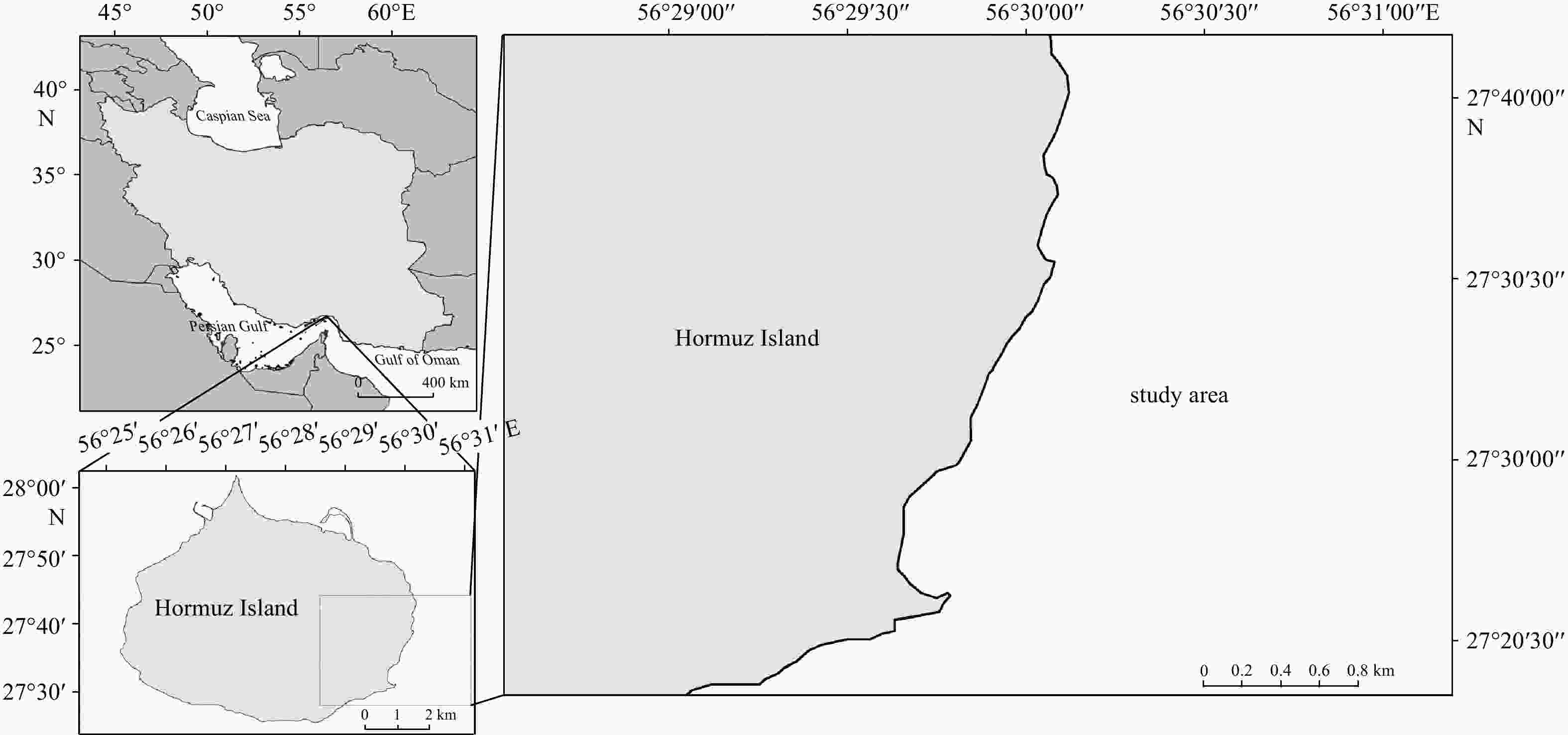
 下载:
下载:
